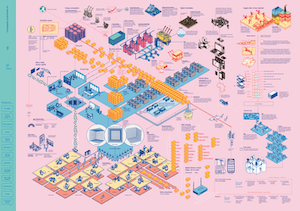This AI Literacy Review covers Estonia’s launch of Europe’s first national AI Literacy Day, Global Call for AI Red Lines to gain international agreement on limiting AI technologies by 2026, lack of AI knowledge and training in South Africa, an illustrative mapping of the connections between humans and AI development, AI literacy assessment for adults, MediaWise and Patrick J. McGovern Foundation’s AI literacy initiatives, Mike Taubman’s AI driver’s license concept, Rebecca Bultsma’s raising awareness of dangers of deepfake apps, Clarivate’s 2025 Pulse of the Library report, Association of College and Research Libraries’ AI Competencies for Academic Library Workers, Center for Democracy and Technology’s report Hand in Hand, KPMG survey of Canadian students and demand for courses on using AI safely, University of Louisiana’s AI microcredential, Oregon State University’s launch of AI Literacy Center, California Institute of Artificial Intelligence’s launch of The Dawn Directive for AI literacy and fluency, Eugenia Novokshanova’s five-part AI literacy in higher education framework, Carnegie Mellon University’s interdisciplinary summer course on AI literacy, George Mason University and Youngstown State University students and Situated AI Literacy framework, Nick Potkalitsky’s Disciplinary Specific AI Literacy framework, opinion piece questioning OECD’s push for PISA 2029 assessment of AI literacy, using AI auditing as an AI literacy exercise for K-12 education, and research articles on AI literacy and students, and gender disparities as early as 5th grade.
General
The scale of artificial intelligence literacy for all (SAIL4ALL): assessing knowledge of artificial intelligence in all adult populations by María T. Soto-Sanfiel, Ariadna Angulo-Brunet, and Christoph Lutz presents an AI literacy scale designed for adults with 56 items across four key themes: what is AI, what can AI do, how does AI work, and how should AI be used.
Poynter’s MediaWise launches an AI literacy initiative titled alt+ignite: Fuel Curiosity, Elevate Your AI Literacy in collaboration with the Patrick J. McGovern Foundation to help prepare 3,000 people across 50 countries in 2025 with AI literacy and ethics knowledge, targeting students, educators, civic leaders, journalists, and library staff.
In One in three South Africans have never heard of AI – what this means for policy, Leah Davina Junck and Rachel Adams from the University of Cape Town discuss their survey of over 3,000 South Africans that found that 37% of respondents had never heard of AI and 36% knew very little about it. Only 4% of respondents learn about AI through formal education and 2% through work or professional training. The authors suggest that more AI literacy efforts are needed, and that companies and civil society organizations and others have a role to play in education and awareness.
Estonia launches Europe’s first national AI Literacy Day, bringing on board 300 participants from across the educator, learning and development, public sector, and NGO sectors to empower them with AI literacy.
The Global Call for AI Red Lines was launched during the UN General Assembly’s 80th session as a call for governments to reach an international agreement on red lines and robust enforcement mechanisms for AI technologies by the end of 2026.
In High schoolers now need an AI driver’s license too: A four-part framework to make students drivers, not passengers Mike Taubman suggests that high schoolers need an AI driver’s license which would ensure they know the promise and peril of using AI tools, just as they do for driving a car. His approach to AI literacy would involve students knowing how to choose a destination with AI, learn to drive the AI tools toward their goal, open the hood and know the limitations, and reflect on the rules of the road and when to turn AI off.
Business Insider’s article LinkedIn’s CEO says these 4 qualities will matter more than fancy degrees in the future workplace by Lloyd Lee covers LinkedIn CEO Ryan Roslansky’s prediction that fancy college degrees will be less valuable than embracing AI, adaptability, and interpersonal skills.
Rebecca Bultsma conducts an experiment on deepfake apps to see how far they let users go to make AI nudes and to raise awareness about the dangers of what’s out there that may be targeted toward children or young people, and how the age verification checks for all of them was just a clickable warning.
Ethan Mollick raises an underdiscussed phenomena called AI-driven role conflict, where work roles are getting blurrier because ‘Everyone can now code a little, design a little, market a little – what does that mean?’ He notes that sometimes people get defensive about their role, and sometimes organizations are rethinking old teams and experimenting.
The collective Estampa creates the Cartography of Generative AI to map and visualize many of the connections between humans, technologies, and the components that go into the development and use of AI.

Libraries
Clarivate’s 2025 Pulse of the Library report featuring insights from over 2,000 librarians from 109 countries/regions across academic, public, and national libraries shows that more libraries are exploring or implementing AI, 56% of librarians know AI requires significant upskilling/reskiling, 52% saw ethical use of AI as a top priority for AI literacy, the U.S. has the lowest optimism about the potential benefits of AI, budget constraints are a key concern, and open access resources are expected to become more important.
The Association of College and Research Libraries (ACRL) has approved the AI Competencies for Academic Library Workers which includes a comprehensive, library-specific set of competencies that build on Leo Lo’s definition of AI literacy, and can guide training programs and other frameworks for librarians.
Education
The Center for Democracy and Technology’s report Hand in Hand: Schools’ Embrace of AI Connected to Increased Risks to Students covers AI usage in schools and four emerging risks, as well as AI literacy, deepfakes, monitoring, privacy issues, and more.
A KPMG in Canada survey of students 18+ finds than 73% rely on Gen. AI for schoolwork, 48% say their critical thinking skills have deteriorated since using it, and 77% want their educational institution to offer courses on using AI ethically and safely.
The UK Department for Education has been investing in upskilling for staff across AI, data, and digital technologies as part of a larger government initiative to improve the workforce and implement AI tools in the public sector.
The University of Louisiana launches an AI microcredential called Empowering AI Literacy for Students which was developed by faculty and staff and is being made available for free to students.
Oregon State University launches an AI Literacy Center as a collaboration between the Libraries and the Center for Teaching and Learning, with Humanities librarian Laurie Bridges as the director. The Center exists to help faculty and students better understand AI and be able to make decisions about teaching and learning.
The California Institute of Artificial Intelligence (CIAI) launches The Dawn Directive as the world’s first AI-generated program for AI literacy, fluency, and ethics to be delivered through the ArthurAI Virtual Learning Platform as an 18-course program across six domains.
Eugenia Novokshanova develops a five-part AI literacy in higher education framework that includes foundational understanding through to transparency and metacognition and expands on it to map the skills to critical thinking and measurable outcomes.
Carnegie Mellon University’s Libraries AI specialist and STEM Librarian Haoyong-Lan teaches an interdisciplinary summer course on AI literacy across 9 weeks to help students explore AI and its role in the research process.
George Mason University and Youngstown State University students in first-year engineering and computing courses will be part of a project led by Professor Aditya Johri to develop AI literacy through use of situated case studies and a Situated AI Literacy framework.
Nick Potkalitsky develops a framework titled DSAIL (Disciplinary Specific AI Literacy) that is designed for schools who lack time and curriculum space for new things, and that works off a single repeatable move of having students encounter AI-generated content and then interrogate it. Teachers don’t have to become technical experts or develop new curriculum, and students receive complementary messages across different classes because they are learning about the limitations of Ai output in each discipline area.
In Why we should be skeptical of the hasty global push to test 15-year-olds’ AI literacy in 2029, J-C Couture, Michele Martini, and Susan Lee Robertson argue that the OECD’s push for PISA 2029 assessment of AI literacy risks sidelineing other important subjects, turning schools into testing grounds for AI development, and not including teachers enough in the discussions around their role.
In Building Critical AI Literacy: An Approach to Generative AI, Sean Kamperman and Kathryn Conrad from the University of Kansas English Department explore critical AI literacy and the value of collaborative learning opportunities relating to digital and AI literacy in education.
In AI Literacy for All: Teaching & Learning from Youth Auditing Black-Box AI Systems, Danaé Metaxa presents a seminar on how using AI auditing as an AI literacy exercise has benefits for K-12 education.
The Cornell Chronicle’s piece Faculty innovate with, and avoid, AI in the classroom by Holly Hartigan covers how different professors are navigating Gen. AI in the classroom and modifying their teaching and assessment practices.
ABC News article Big Tech is paying millions to train teachers on AI by Jocelyn Gecker covers how companies like Microsoft, OpenAI, and Anthropic are funding AI training through the two biggest teachers unions: the National Education Association and the American Federation of Teachers.
In Influence of AI literacy and 21st-century skills on the acceptance of generative artificial intelligence among college students, Reham Salhab and Mosab M. Aboushi survey 260 students about their AI literacy and 21st-century skills, concluding that curriculum should be enriched with AI literacy.
In A framework for AI ethics literacy: development, validation, and its role in fostering students’ self-rated learning competence, Junfeng Yang, Wenyuan Xie, and Junjie Ni study the relationship between AI ethics literacy and students’ self-rated learning competence using AI, finding that there are usually four ethical principles considered in AI ethics: fairness and inclusivity, privacy protection, human-centricity, and responsibility and accountability.
In Promoting teaching innovation among university teachers through AI literacy from the perspective of planned behavior: the moderating effects of three perceived supports, Yuping Zhao and Ling Huang use the Theory of Planned Behavior to look at how AI literacy promotes teaching innovation, finding that it enhances teachers’ attitudes and does lead to more innovation.
In AI literacy predicts computational thinking through multidimensional interactions among Chinese high school students, Yurong Guan et al. explore the relationships between three dimensions of AI literacy and five dimensions of computational thinking, finding that parental education and more frequent use of AI tools have a significant impact on AI literacy.
In AI literacy and gender equity in elementary education: A quasi-experimental study of a STEAM–PBL–AIoT course with questionnaire validation, Chih-Chan Cheng et al. found gender disparities in AI literacy in 5th grade students but that these could be reduced through targeted AI literacy education.
Punahou School in Honolulu, Hawai‘i offers 5th grade students an eight-lesson AI literacy unit to help them think about AI in daily life and the ethical implications, led by Nicole Schofield as part of a Center for Teaching and Learning grant.
In Assessing AI literacy in second language writing: a scale development and validation study [paywalled], Zhiyun Huang et al. valides an AI Literacy in L2 Writing Scale for ESOL learners in China to measure their ability to use AI tools.
In What past education technology failures can teach us about the future of AI in schools for The Conversation, MIT Professor Justin Reich cautions that AI is too new and changing too quickly for much certainty, so educators should have humility while they experiment and assess.
Research from Adobe and Edelman shows that college campuses with access to Adobe’s Creative Campus program have students who report higher AI literacy (83%) compared to students at other campuses (63-73%), even outside of design and media programs.


